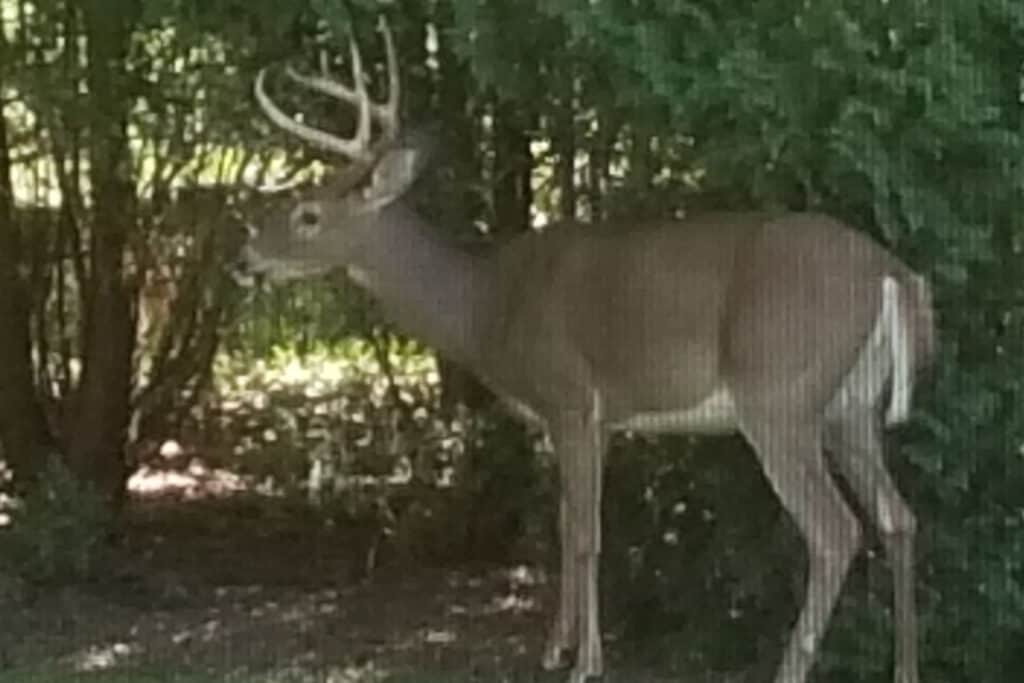
I used to love the deer that came through my property. They are graceful, peaceful animals that are demonstrably protective and affectionate with their young. They are beautiful creatures — That are now entering my fenced yard and eating my mature arborvitae down to the trunk. As with most homeowners with landscapes that have been planted and maintained with a certain degree of love and care, this situation will not do.
Gaining an understanding of deer feeding behavior is the key to dissuasion of deer browsing and downright grazing on our precious plantings.
Important factors that affect the rate of damage deer will do to your landscape:
- The availability of alternative food sources – if your yard provides what deer want, they are coming to your house
- Weather conditions – will certainly change the availability of alternatives
- Size of the deer population in your immediate area
My subsequent research on this subject shows that deer are not generally partial to arborvitae. This shrub/tree is, essentially, a fall-back choice for deer. Deer tend to like the more succulent, herbaceous plants; like hostas and daylilies, to name a few. In the warmer months, they tend to try to feed off my other ornamental trees and plants and leave the arborvitae alone.
In the winter, however, when the deciduous plants are not as available, evergreens trees like the arborvitae, hemlock, laurels, and rhododendrons can be the only opportunities left to the deer.
Will My Arborvitae grow new needles and branches once the deer have eaten them?
The bad news is that your arborvitae branches, once eaten to the point of bare branches, will not come back. The good news is that deer rarely eat all that’s there. Even with hostas. I have seen evidence of them eating them down to almost nothing but leaving enough to grow back in a few weeks where the deer might be able to keep coming back to feed again and again. There is hope if there are still a few needles on the arborvitae.
As the Spring returns and allows for more nutritious deciduous growth, the pressure the deer bring to your landscape will likely change, reducing the rate of damage being done to your evergreens.
Things you can do to mitigate the damage done without having to hire a professional:
- Deer fencing/netting which forms a physical barrier to the susceptible plants
- Repellents
- Planting more deer resistant trees, shrubs and plants
Deer Fencing/Netting
There are many types of fencing deterrents ranging from protecting individual plants to fencing in the yard as a whole.
While fencing the yard is, logically, more permanent, the downside is the expense and subsequent maintenance that would go with it. As well, a “deer fence” would have to be exceedingly tall – at least 8 feet, as deer, can jump quite high. (I have a 4-foot fence surrounding the portion of my backyard containing my arborvitaes. It’s no deterrent at all, even to yearlings).
For me, an 8-foot fence could well begin to make my backyard look like a prison yard from the street. Wooden barriers can look warmer, and may provide some extra privacy as well. They will not necessarily be a look everyone would appreciate. Also, they too will come with quite a bit of expense and maintenance.
Instead of actual fencing around a yard, it might be better to do a deer net wrapping around your arborvitae during the Winter months. The deer will have a much harder time eating through the netting and will move on.
When Spring arrives, you will be able to unwrap your shrubs thereby allowing them to open up and flourish during the warmer months. The deer, at this time, will likely be after other plants, as mentioned, thereby leaving your arborvitae safe from harm.
Deer-Resistant Plants
Staying with arborvitae for the moment:
Arborvitae, also known as Thuja, are commonly used ornamentally as hedges. There are several species of Thuja, and they have within, reputedly, different resistances to infestation and grazers. White Cedar, Thuja occidentalis, is found in Eastern states and, is more often eaten by deer than its cousin, the Western Redcedar, Thuja plicata. Western Redcedar is left alone likely because it contains more in the way of what is known as Terpenes, a component of Turpentine, which acts as antifeedants (compounds made by the plant to ward off insects and other consuming animals like deer). The Western Redcedar isn’t found so readily in the Northeast. Perhaps a specialty nursery may be able to help.

On the other hand, if you can be patient, replacing with the Eastern Cedar Arborvitae, at about 6-7 feet tall can be had for about $175.00. The best part is that they grow up to 5 feet per year when they are young. It’s a little bit of catch-up as far as time goes. But, it could be worth it if you can keep it healthy.
There are also various species of laurels, holly, etc. with varied colors and leaf sizes that will provide proper barriers and, in time, perhaps some shade as well. These too, are very resistant to deer grazing. Check with your local nursery to see if mature trees and shrubs of these types might be available. Otherwise, most can be found in young, seedling stages on Amazon.
If this idea interests you, please feel free to visit the University of Massachusetts Amherst’s website which includes their extensive list of Perennial deer resistant trees, shrubs, and plants.
Going this route can limit the decorative choices available. However, I have skip laurels in my gardens. They are quite beautiful, they grow quickly and are quite hardy. What’s more, the deer don’t eat them. The same hardiness is shared in the various holly trees I have growing which also have great variety in leaf size and color.
Deer Repellents
My feeling on deer repellents is that they do work well… but, sometimes, not on every deer.
These products, by and large, are meant to ward off deer by way of harsh smell, and bad taste and some have the built-in scent of deer predators. After many different trials with many different products, I have come to use Liquid Fence Deer & Rabbit Repellent Concentrate.
While it’s difficult to overstate the smell of the product during and shortly after its application (pungent to say the least). In a short time, the odor does dissipate. The deterrent effect for the deer, however, who have an incredible sense of smell, remains quite strong keeping them at bay.
A note: Just as there are different tastes among people, there are sure to be some deer who can power through the smell intended to deter and keep on eating. Some people can eat Lutefisk, Haggis, and Limburger Cheese. It seems logical that some deer may get past the Liquid Fence. But, in my area (Northern NJ) and with my deer population, this product does a great job keeping my hostas alive through the Spring and Summer.
Safety Note: I think that it’s important to mention that you should always read the label on these types of products that you buy. Some are not meant for vegetation that you or your family intend to eat. Please exercise proper caution and diligence.
Repellents can usually be applied to plants directly or used as an area treatment creating a chemical barrier. Studies from the USDA Forest Service and the University of Massachusetts have shown that the proper use of certain deer repellents can make dramatic differences.
The Hybrid Approach
To begin with, if you mean to keep your arborvitae, the planting of deer-resistant shrubs and trees may help to some degree. Although logically, if the deer like the arborvitae you mean to protect that are close by, more than the other plants you will place in your yard, the deer will, by default, go back to your arborvitae.
This brings us to the hybrid approach of strategic planting and using deer repellants. Depending on how much of the inconvenience, diligence, and responsibility of repellant usage you are willing to manage, using a hybrid approach of proper plantings and liquid deterrents will greatly expand the number of choices you will have with your other plantings.
To conclude, I intend to try out a deer-resistant netting this Winter to at least make the feeding on my arborvitae more difficult for the deer. I will update this article with the results of the experiment.
There is an Update!
I have successfully placed a deer deterrent and have a video of it in use and WORKING to discourage deer from my trees!
Check it out!!
Best of Luck
Berk
